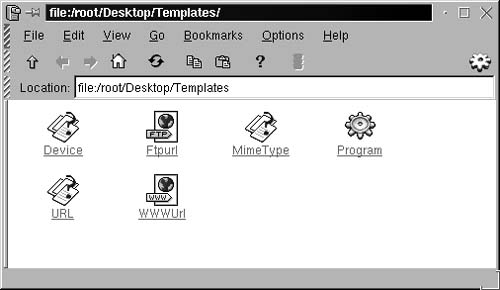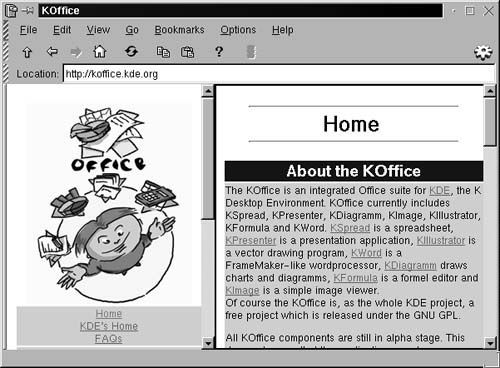Using the K Desktop Environment
The K Desktop Environment, also called KDE, is somewhere between Fvwm and Gnome. It is not as stripped down as the former, but not as full featured as the latter.
KDE should be familiar to users of earlier versions of Red Hat Linux, because prior to version 6 it was the default X-Windows shell.
If you explore KDE, you'll find quite a few interesting and useful applications and utilities that are not available in the other desktop environments.
To start KDE:
1. | Make sure that your system is set to automatically start X-Windows, as explained in Chapters 1 and 2. |
2. | At the Red Hat Linux logon screen, click Options. On the Sessions fly-out menu, choose KDE. |
3. | Enter your ID and password. |
4. |
Figure 6.9. KDE is a full-featured windowing environment.

The KDE Control Center
Many aspects of KDE can be configured using the KDE Control Center.
To open the KDE Control Center:
1. | Click K at the lower left of the KDE window. The K Start menu will open. |
2. | |
3. | Choose the feature you want to configure from the expandable list in the left pane. |
Figure 6.10. Many aspects of KDE can be configured using the KDE Control Center.

The KOffice suite
The KOffice suite is a full-fledged suite of office software applications created as free software under GNU open licensing arrangements. KOffice is under continual development, meaning that some features and components may not be completely finished. The applications that are part of the KOffice include:
KSpread, a spreadsheet program similar to Excel
KPresenter, a slide presentation program along the lines of Powerpoint
KIllustrator, a drawing program along the lines of CorelDraw
KWord, a word processing program
KDiagramm, a charting and diagramming program
KFormula, a scientific formula editor
To install KOffice:
1. | Open a KDE file window. KDE file windows function both as file managers and Web browsers. An easy way to open a file window is to double-click the Templates folder which is placed by default on the KDE desktop. If you double-click this folder, a file window will open showing the contents of the folder (Figure 6.11). Figure 6.11. KDE file windows serve a dual purpose as Web browsers.
|
2. | Make sure your computer is connected to the Internet. |
3. | |
4. | Press Enter. The KOffice home page will open (Figure 6.12). Figure 6.12. You can download the KOffice suite from the KOffice site.
|
5. | Follow the links at the KOffice site to download via FTP the packages containing the source code for the KOffice applications. |
6. | Compile the source packages following the instructions located at http://koffice.kde.org/install-source.html |
To quit KDE:
1. | Click K at the lower left of the KDE window. The K Start menu will open. |
2. | Choose Logout. The Logout window will open. |
3. | Click Logout. |
Using Another Level and KDE menus from GnomeMuch of the KDE and Another Level menu system can be accessed from the Gnome desktop environment.
|


